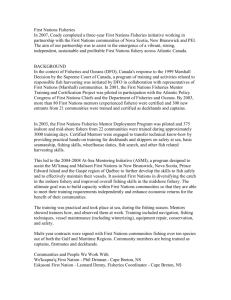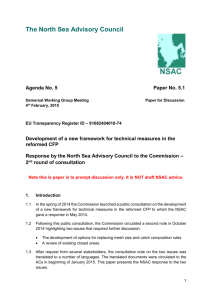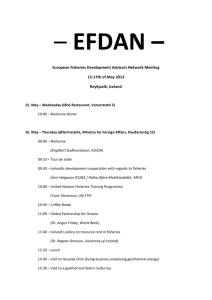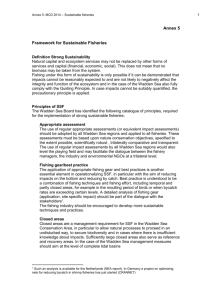Final Report - The Rufford Foundation
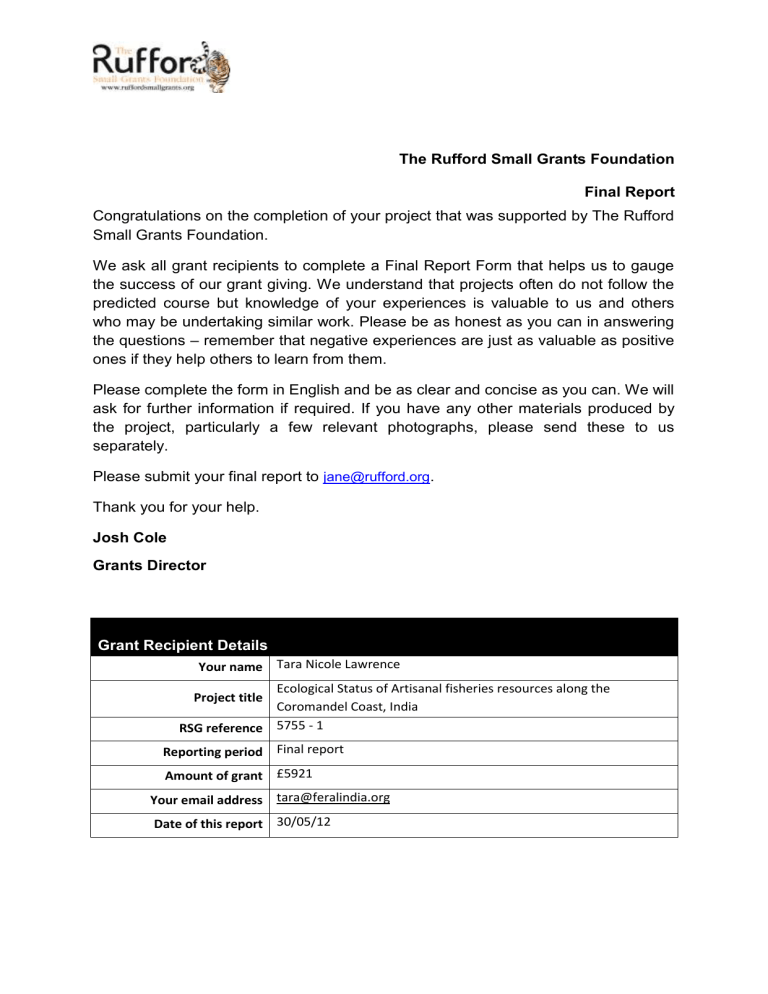
The Rufford Small Grants Foundation
Final Report
Congratulations on the completion of your project that was supported by The Rufford
Small Grants Foundation.
We ask all grant recipients to complete a Final Report Form that helps us to gauge the success of our grant giving. We understand that projects often do not follow the predicted course but knowledge of your experiences is valuable to us and others who may be undertaking similar work. Please be as honest as you can in answering the questions
– remember that negative experiences are just as valuable as positive ones if they help others to learn from them.
Please complete the form in English and be as clear and concise as you can. We will ask for further information if required. If you have any other materials produced by the project, particularly a few relevant photographs, please send these to us separately.
Please submit your final report to jane@rufford.org
.
Thank you for your help.
Josh Cole
Grants Director
Grant Recipient Details
Your name Tara Nicole Lawrence
Project title
Ecological Status of Artisanal fisheries resources along the
Coromandel Coast, India
RSG reference 5755 - 1
Reporting period Final report
Amount of grant £5921
Your email address tara@feralindia.org
Date of this report 30/05/12
1.
Please indicate the level of achievement of the project’s original objectives and include any relevant comments on factors affecting this.
2.
Objective Comments
1. Creation of a disaggregated baseline to address the paucity of data within the artisanal fisheries sector regarding current resource base and exploitation levels
(mainly fishing effort)
2. To use the baseline for further research into specific aspects of fisheries ecology research with the aim to advise fisheries management and conservation for the region.
X This was a highly data intensive project exceeding 2500 boats fishing over the sampling period along with the subsequent catch from each boat to be examined. With a team consisting of only two members, this proved a bit ambitious where data entry was concerned and is therefore the main reason for the delay in project completion.
X
3. To use the project's findings as a sounding board for management. co-
X
1 Fisheries Management for Sustainable Livelihoods
The database will be processed to examine important questions such as the present status of the resource base and if present management policies are relevant in the given context. The entire catch was recorded even though our primary focus was on the fish catch. Thus, crustaceans, molluscs and echinoderms were also recorded along with bycatch allowing further research into these specific groups as well. It is important to note that the supposed systems in place for fisheries management at the moment are yet to change or adapt to suit local conditions. The government fisheries department are only just beginning to realize the serious need for management at a time when the fishing community are increasingly restless, strongly reacting to any external interventions.
Larger projects like FIMSUL 1 , BoBLME 2 as well as other FAO funded efforts appear to prioritise comanagement and alternative livelihoods lacking concern over the resource base which is where the baseline and subsequent findings of this project will make a significant contribution.
We continue to interact with the fishing community on a regular basis and the outcomes of this project will be translated into the regional language i.e., Tamil, which would then allow for
2 Bay of Bengal Large Marine Ecosystem
local interventions to take place such as the prevention of using a particular type of gear during the breeding season or fishing in a certain area depth where only juveniles or gravid species appear to be found. A project recently funded by the Department of Science and
Technology, New Delhi is looking at comanagement and livelihood enhancement in the study area and the information from this project will be disseminated to the fishermen during these stakeholder and co-management meetings.
This is presently being explored and a proposal for the Andaman Islands is currently underway.
4. Potentially extend this work to sensitive areas such as the Gulf of
Mannar and the
Andaman Islands
X
2.
Please explain any unforeseen difficulties that arose during the project and how these were tackled (if relevant).
1.
This project expanded upon earlier work to a total of 30 villages with the majority of them having a fishing capacity of more than 50 boats per village. It is crucial for the fishermen to return in time for the auctioning of catches as that is when the rates for their catch are decided. If they miss this timing, then the price for their catch decreases dramatically. It is usually during this time that the catch comes in at an overwhelming speed over a fairly large area. In order to capture most of the fishing effort for the day if not all of it, two field assistants were assigned the task instead of one. This naturally had budget implications.
2.
The development of two short term projects within the same time frame proved to be challenging in terms of allocation of human resources. These were the FIMSUL and the
BoBLME projects. These projects involved conducting several meetings at the village and district level on co-management and livelihood alternatives therefore requiring a field team preferably from the community. FERAL has been working with the fishing community since 2007 and on account of our experience with the community, the
FIMSUL and BoBLME team developed a collaboration with FERAL to work in the two districts of Cuddalore and Villupuram and the state of Pondicherry. The projects were field intensive and with only two members on the team from the community, a few adjustments to the field data collection and entry schedule were needed to ensure the work continued.
3.
Briefly describe the three most important outcomes of your project.
1.
The direct and most important output of this project is the baseline itself. This will serve as the foundation upon which all other efforts will be based and is the first of its kind for the area. The disaggregated nature allows for specific aspects to be researched and built upon further along with the several relationships the database could potentially reveal.
Additional to catch specifics, the database also contains the largest record of where
fishermen go and which type of gear and craft operate in the area. These factors are very crucial to any management strategy that may be devised and implemented within the region. The reason being that the fisheries sector is highly dynamic constantly adapting to the prevailing and changing resource in the face of economic pressures and therefore any management strategy has to be malleable enough to address issues at the local level rather than behave as blanket solutions.
2.
Ecosystem based management is yet to be considered as at the moment the focus seems to be on people or rather effort management without much concern over the resource base or habitat. For efficient management however, this alone may not work and has to happen alongside managing the resource with adequate knowledge on the ecology of the area. The baseline will take these factors into consideration including habitat - species distributions which could potentially determine ecologically sensitive or vulnerable areas thereby having direct implications on management.
3.
Publications in peer reviewed journals covering aspects of species diversity and distribution, age and growth of fisheries resources, policy recommendations as well as socioeconomic status of artisanal fisheries along the Coromandel Coast, to mention a few will be further used to influence local management efforts. They will add far more substantially to the process and have a better standing on the policy front along with organizations such as the FAO, CMFRI 3 , SIFFS 4 and government departments.
4.
Briefly describe the involvement of local communities and how they have benefitted from the project (if relevant).
1.
None of our endeavours occurred independent of the fisherfolk. FERAL has been working along the Coromandel Coast for the last 5 years and have therefore been interacting with the fishing community almost on a regular basis.
2.
Immediate benefits to the people are not relevant in this context. In the long run however, and through local practical interventions (such as artificial structures and no fishing periods), larger catches and increased individual sizes would be the result and this would directly benefit the fisherfolk.
5.
Are there any plans to continue this work?
1.
The Department of Science and Technology, New Delhi, India has recently funded a study exploring co-management within the artisanal fisheries sector inclusive of mechanized fishing. The overall aim is to feed into general fisheries management programs and policy recommendations pertaining to India as well as the states of Tamil
Nadu and Pondicherry through publications in popular press and relevant scientific journals. The focal areas of this project are as below and will be integrated with the baseline.
1.
Seasonal patterns in fishing groups and gear utilisation.
2.
Credit and subsidy mechanisms in the formal and in-formal sector.
3.
Marketing linkages and processes for both domestic and export markets.
3 Central Marine Fisheries Research Institute
4 South Indian Federation of Fishermen's Societies
4.
Impacts of artificial structures on local fish catch and mapping fishing effort across the Coromandel Coast.
6.
How do you plan to share the results of your work with others?
1.
The results of this work will be shared primarily via publications in peer reviewed journals. In addition to scientific papers, this work will also be presented at symposiums and conferences with themes relating to ecology, biodiversity and conservation.
2.
Additionally, FERAL participates in several meetings related to coastal and fisheries issues and these are the platforms where this work will be shared and publicised locally and nationally. Co-management workshops with the key stakeholders in the fisheries sector on the DST project provide an opportunity for the fishermen to understand the importance of such work and the need for them to begin management locally.
7.
Timescale: Over what period was the RSG used? How does this compare to the anticipated or actual length of the project?
The grant was used for the proposed project period of 18 months. However, more time could have been planned for data entry as the total project period amounted to 20 months. As this was not anticipated, it naturally had budgetary implications.
8.
Budget: Please provide a breakdown of budgeted versus actual expenditure and the reasons for any differences. All figures should be in £ sterling, indicating the local exchange rate used.
Item Budgeted
Amount
Actual
Amount
Difference Comments
Particulars
Staffing
JRF =1 (18 months)
GBP
1,846
GBP
1,384
GBP
462
Field asst =1 (18 months) 1,431
Equipment
Water proof camera – 1
Camera case (Neoprene all weather case – 1
X D picture 10 card ( M
Plus 1 GB)
188
9
10
1,936
246
17
61
-505
-58
-8
-51
@ INR 70.88
An additional person was required due to the volume of field data collection. Stipends to staff had to be adjusted in order to make this addition.
2 assistants were retained for field data collection.
The model selected was no longer available and a higher model with the same hardy features was purchased.
The model selected was not available locally.
Cards lost or damaged needed to be replaced. Additionally, indirect costs such as printing of data sheets, maintenance of desktop
Fish Scale
Travel
Bike rental maintenance months)
Travel to field (Fuel) – (15 months)
Inflation rate @10% -
15months
Field expenses
Food and lodging on field
- 2 persons - 15months
Purchase of fish
Total
&
(15
27
577
577
115
833
308
5,921
0
762
395
0
803
317
5,921
27
-185
182
115
30
-9
0 machine is supported by the relevant project.
Fish scales were purchased later on a different program and were therefore not required to be purchased on this project.
Maintenance of motorbikes proved more expensive. Bikes revolved with field staff on other projects as a result of which bikes were not always in a safe and usable condition. As field sites were remote and distant, regular maintenance was needed to ensure safety of field staff on this project.
This was adjusted against the maintenance costs.
Due to the several hikes in fuel prices, this line was included to be able to cope with it.
Remote villages often had meagre food stalls with basic preparations being subsequently cheaper. This compensated for the more expensive hotels closer to the main towns.
Fluctuating fish prices combined with the need for sufficient samples species wise.
Unplanned expenses were hiring an additional assistant on the team at the same remuneration, purchasing materials and supplies, and maintenance of computers used on the project.
9.
Looking ahead, what do you feel are the important next steps?
1.
The most important step would be to dissipate this information to fisherfolk and prominent stakeholders within the fisheries sector via co-management meetings, scientific research publications, seminars and symposiums.
2.
Spreading awareness among the Government fisheries officials on effective data collection would also be an important step as the FAO of the UN depend on each country's local departments for their annual fisheries statistics world over. There is
currently very controversial information (if any!) as to what the present resource base is and there is a clear need to improve methods of data collection and reporting the same.
3.
Streamlining fisheries work along this part of the coast looking into specific aspects such as population status of pelagic fisheries, using the baseline as the foundation thereby developing related research projects addressing these issues. This would not only contribute to the baseline by way of filling gaps but would also strengthen the existing baseline.
10.
Did you use the RSGF logo in any materials produced in relation to this project? Did the
RSGF receive any publicity during the course of your work?
1.
The RSGF logo was not used as there were no material outputs from this project.
2.
RSGF will receive publicity from the research papers that will be published as the outcomes of this project.
11.
Any other comments?
I would like this report to be published on the RSG website along with the manuscript that will be developed shortly, comprising the findings of this project.



